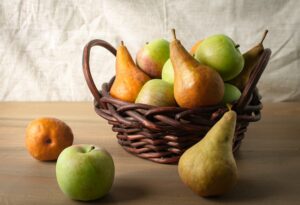FRUCTOSE AND THE LIVER

In recent decades, sugars have played the role of dietary demon, with fructose being singled out as the worst of them all, being described as toxic, poison, etc…by a variety of popular anti-sugar activists, who suggest it is responsible for rising rates of obesity around the globe, amongst other things. One of the reasons that fructose has been singled out is because it was believed to be primarily converted to fat in the liver. Recent research challenges that belief.
What is fructose?
Fructose is one of the most abundant sugars in nature, being the main sugar in fruits, berries, honey, flowers, most root vegetables, and some grains. Nowadays, it is also abundant in the supermarket – when you buy soft drinks and sweetened foods such as yoghurt, dairy-based and frozen desserts, biscuits/cookies, cake mixes, salad dressings, mayonnaise, sauces (e.g., tomato), and some soups (again, e.g., tomato), chances are you will be adding fructose to your diet in the form of sucrose (50 percent fructose and 50 percent glucose) or high fructose corn syrup (HFCS: typically 55 percent fructose and 45 percent glucose), depending on what part of the world you live in (HFCS are primarily used in North America).
Pure fructose is about 70% sweeter than sucrose (table sugar), so in theory less can be used to comparably sweeten a product. It also provides slightly less energy than sucrose – 15.6 kilojoules per gram compared to sucrose’s 16.5 kilojoules per gram (g). Finally, it has the lowest GI of all of the commonly consumed sugars, with an average value of 19 (low), compared to sucrose’s GI of 65 (medium).
Fructose digestion, absorption and metabolism
Sucrose is broken down into its constituents glucose and fructose in the small intestine with the help of the digestive enzyme sucrase, which is located in the small intestinal villi. Glucose is actively transported into the small intestine cells with the help of sodium and quickly ends up in the portal circulation (the blood supply from the small intestine to the liver) where it is distributed to the rest of the body, as it is the preferred fuel for most of our body’s organs and tissues.
Regardless of the source (i.e., from sucrose, HFCS, or pure fructose), fructose is passively transported into the small intestinal cells. Until recently, it was commonly believed that the liver was the primary site of fructose metabolism. An elegant study by Cholsoon Jang and colleagues has proven that this is not the case. Using isotope tracing and mass spectrometry, they tracked the fate of carbon molecules from glucose and fructose in vivo. They found that when low doses of fructose are consumed, around 90% is cleared by the small intestine, with only trace amounts of fructose, but extensive fructose-derived glucose, lactate, and glycerate found in the portal circulation.
However, high doses of fructose (more than 1 g/kg, equivalent to more than 72 g for an average Australian woman and more than 87 g for an average man) overwhelm intestinal fructose absorption and clearance capacity, resulting in fructose reaching both the liver and the large intestine, where it is metabolised by the colonic microbiota. It is important to note that it has long been known that large doses of pure fructose are not well absorbed by humans, causing flatulence and diarrhoea in most people when it reaches the large intestine.
Overall, the authors concluded that the small intestine shields the liver from fructose exposure and that large doses of fructose overwhelm this shielding capacity.
How much fructose are we consuming?
While most national nutrition surveys provide estimates of how much total and added sugars people consume, they don’t provide estimates of how much fructose people consume. However, if we assume that half of the total sugars we consume are fructose (on average, around 50% of the sugar in fruits is fructose, for example), we can get a rough estimate of how much we are consuming.
For example, in Australia’s most recent National Nutrition Survey, on average, women consumed 91g of total sugars and men 115g. If half of all sugars consumed are fructose, then women consumed approximately 45.5 g of fructose and men 57.5 g.
Therefore, on average, Australian women and men are not consuming high amounts of fructose, and therefore, most of what they are consuming is converted into glucose in their small intestine, and not to fat in their liver, as has been popularly believed.
Conclusion
When consumed in typical amounts, fructose is converted to glucose in the small intestine – not fat in the liver.
Read more:
- Barclay and colleagues. The Ultimate Guide to Sugars and Sweeteners. The Experiment, 2014
- Jang and colleagues. The Small Intestine Converts Dietary Fructose into Glucose and Organic Acids. Cell Metabolism, 2018.
- Australian Bureau of Statistics. Australian Health Survey: Nutrition First Results – Foods and Nutrients. 2011-12.








